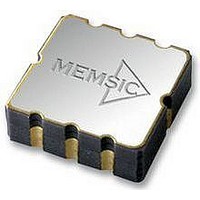MXC62020MP MEMSIC, MXC62020MP Datasheet - Page 7

MXC62020MP
Manufacturer Part Number
MXC62020MP
Description
ACCELEROMETER, 2 AXIS, ±2.0G, I2C
Manufacturer
MEMSIC
Datasheet
1.MXC62020MP.pdf
(10 pages)
Specifications of MXC62020MP
No. Of Axes
2
Sensor Case Style
LCC
No. Of Pins
8
Supply Voltage Range
2.7V To 3.6V
Operating Temperature Range
-40°C To +85°C
Operating Temperature Max
85°C
Operating
RoHS Compliant
Acceleration Range
±2g
Available stocks
Company
Part Number
Manufacturer
Quantity
Price
Company:
Part Number:
MXC62020MP
Manufacturer:
ATT
Quantity:
5 624
Part Number:
MXC62020MP
Manufacturer:
MEMSIC
Quantity:
20 000
THEORY OF OPERATION
The MEMSIC device is a complete dual-axis acceleration
measurement system fabricated on a monolithic CMOS IC
process. The device operation is based on heat transfer by
natural convection and operates like other accelerometers
except it is a gas in the MEMSIC sensor.
A single heat source, centered in the silicon chip is
suspended across a cavity. Equally spaced
aluminum/polysilicon thermopiles (groups of
thermocouples) are located equidistantly on all four sides of
the heat source (dual axis). Under zero acceleration, a
temperature gradient is symmetrical about the heat source,
so that the temperature is the same at all four thermopiles,
causing them to output the same voltage.
Acceleration in any direction will disturb the temperature
profile, due to free convection heat transfer, causing it to be
asymmetrical. The temperature, and hence voltage output
of the four thermopiles will then be different. The
differential voltage at the thermopile outputs is directly
proportional to the acceleration. There are two identical
acceleration signal paths on the accelerometer, one to
measure acceleration in the x-axis and one to measure
acceleration in the y-axis. Please visit the MEMSIC
website at www.memsic.com for a picture/graphic
description of the free convection heat transfer principle.
MXC6202xG/H/M/N PIN DESCRIPTIONS
V
sensor heater in the
be between 2.7 and 3.6 volts. Refer to the section on PCB
layout and fabrication suggestions for guidance on external
parts and connections recommended.
GND– This is the ground pin for the
COM– This pin should be connected to ground.
TEST– Do Not Connect, factory use only.
VDD2– This pin is the I
voltage on this pin determines the I
and is 1.8V compatible. Note: The voltage on this pin
should never go higher than the voltage on V
has a lower power supply voltage than V
be applied to V
SDA– This pin is the I
FAST (400 KHz.) mode.
SCL– This pin is the I
FAST (400 KHz.) mode.
MEMSIC MXC6202xG/H/M/N
DD
– This is the supply input for the circuits and the
DD
first.
accelerometer
2
2
C serial clock line, and operates in
C serial data line, and operates in
2
C input digital power supply, the
. The DC voltage should
Rev.C
2
C bus logic voltage,
accelerometer
DD
, power should
DD
, if VDD2
.
Page 7 of 10
DISCUSSION OF TILT APPLICATIONS AND
RESOLUTION
Tilt Applications: One of the most popular applications of
the MEMSIC accelerometer product line is in
tilt/inclination measurement. An accelerometer uses the
force of gravity as an input to determine the inclination
angle of an object.
A MEMSIC accelerometer is most sensitive to changes in
position, or tilt, when the accelerometer’s sensitive axis is
perpendicular to the force of gravity, or parallel to the
Earth’s surface. Similarly, when the accelerometer’s axis is
parallel to the force of gravity (perpendicular to the Earth’s
surface), it is least sensitive to changes in tilt.
Following table and figure help illustrate the output
changes in the X- and Y-axes as the unit is tilted from +90°
to 0°. Notice that when one axis has a small change in
output per degree of tilt (in mg), the second axis has a large
change in output per degree of tilt. The complementary
nature of these two signals permits low cost accurate tilt
sensing to be achieved with the MEMSIC device (reference
application note AN-00MX-007).
X-Axis
Orientatio
n
To Earth’s
Surface
(deg.)
90
85
80
70
60
45
30
20
10
5
0
Accelerometer Position Relative to Gravity
X Output
Changes in Tilt for X- and Y-Axes
1.000
0.996
0.985
0.940
0.866
0.707
0.500
0.342
0.174
0.087
0.000
(g)
X-Axis
per deg.
Change
of tilt
(mg)
17.37
17.45
12.23
15.04
16.35
17.16
0.15
1.37
2.88
5.86
8.59
Y Output
0.000
0.087
0.174
0.342
0.500
0.707
0.866
0.940
0.985
0.996
1.000
(g)
Y-Axis
2
/26/2007
per deg.
Change
17.45
17.37
17.16
16.35
15.04
12.23
of tilt
(mg)
8.59
5.86
2.88
1.37
0.15













